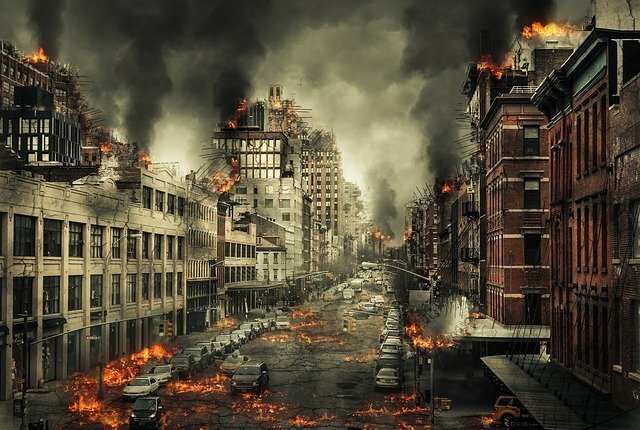If we fall, we’ll get back up again. If we tear it down, we’ll rebuild, bigger and better. That’s what we tell ourselves. That’s what we believe.
That isn’t necessarily what happens, as the ruined cities and collapsed civilizations scattered around the world demonstrate.
Where does this belief come from? And how does it affect societies, both in the real world and in science fiction?
Background: The Generational Cycle Theory
The “Fourth Turning” theory suggests that societies go in cycles, typically over four generations. This is separate from the cyclical theory of civilizations, the idea that civilizations themselves rise and fall. With these theories, it is assumed people will rebuild again and again. (For a worst case scenario, see the Battlestar Galactica reboot.)
The belief that we’ll repeat prior mistakes or build back better after a fall is so strong that you must have something like a religious prohibition and institutions in place to prevent it, if you don’t want it to happen. See the Orange Catholic Bible’s prohibition on artificial intelligence in the “Dune” universe or the Church of God Awaiting in “Safehold”.
I think this theory is built into our cultural fabric, such that it is assumed that society will rebuild to something similar or “better” after an apocalyptic event – as long as we survive. If we don’t survive, you can find plenty of science fiction novels where intelligent baboons (At Winter’s End), mutants, or robots (Saturn’s Children) survive and continue the cycle.
What is the source of the assumption that we WILL rebuild in some way, shape or form? It is a belief we owe to Judaism and later Christian theology, that the future will be better, even after a “fall”. (Hat tip: Thomas Saint Thomas). That is embodied in the myth of Noah (the original post-apocalyptic tale) and the Book of Revelations.
Yet there are few books and stories go into detail about the rebuilding of society after the collapse. Let’s look at a few of the reasons why.
Why So Many Stories Feature the Threat or Actual Collapse but Little After
The fall of civilization dominates apocalyptic and post-apocalyptic fiction. It is easy to imagine the fall of civilization. It could be a gradual decline into decadence into nothing to a sudden bang, including a nearby sun going supernova or some other interstellar phenomena. Environmental disasters have taken the place of nuclear war as the most popular cause in modern literature. Here, you either see the collapse, the fight for survival immediately thereafter, or dealing with the aftermath years later.
From “Divergent” to “The Gate to Women’s Country”, we see a very different world generations removed from the disaster. Modern movies like “Equilibrium”, “Ultraviolet” and “Equals” mention or show the disaster that led to the dystopian world gloss over how they got to that point. The disaster that nearly wiped out civilization in these cases only serves as the explanation for the new world order. They are, at best, working toward their version of “better”. Or preventing a repeat of the horrors is their excuse for their current dystopia.
The Diamond Age is implied to be a sequel of Snow Crash, because an elderly black woman in The Diamond Age is probably YT from Snow Crash. In this case, it is obvious that the development of controlled nanotech saved society and led to the new one. But we don’t see the rebuilding itself in the intervening decades.
In most cases, someone’s quest ends with the discovery of the Holy Grail promising to save everything. Anthem by Ayn Rand ends with the genius and his lover going off to rediscover technology, leaving the mere hope humanity itself will be saved when they choose to come back. In Atlas Shrugged, we see the collapse of society and the heroes deciding to return to the world from Galt’s Gulch. But we don’t see the reaction of people to their arrival or the long hard process of rebuilding. What happens if they’re rejected? And what if it isn’t enough?
Here’s the more important question: what causes the collective tide to turn from downward slide to an upward trend in general? And why do we have so few examples of it?
The Slow Deliberate Rebuilding of Civilization
The slow rebuilding of society is infrequently found in science fiction, though there are a few well-known examples. “A Canticle for Leibowitz” is a classic example of this trope. It shows the rebuilding of a society in three parts, with the first taking place not long after a massive nuclear war and the last taking place more than a millennium later.
In the Codominium stories by Jerry Pournelle and Larry Niven, the rebuilding of humanity’s interstellar empire takes centuries both times. It is only unusual for having two empires knowingly following each other set in the same universe. And the first Empire of Man only occurred because Earth itself was destroyed in a nuclear war. The “War World” anthologies show several inflection points in the history of Haven, a colony world.
The “Foundation” series by Isaac Asimov is one of the few series where they spend several books trying to rebuild. Harry Seldon realizes they can’t halt the collapse of interstellar civilization, something occurring so slowly that even historians are blind to it. He founds an organization with the goal of shortening the dark ages from tens of thousands of years to just a thousand years.
Why are these stories rare? Because it is relatively boring compared to a fight for survival or fighting the dystopian government that took power after the disaster. Thus “Canticle for Leibowitz” focusing on human drama, while the “Foundation” series relies on quests for answers to keep the reader reading.
The Awakening from Decadence and Decline
Inertia is powerful. Furthermore, if you think that peace and prosperity are the definition of perfect, why would you change? Just offer more drugs, increased social control, or a greater number of nanotech implants since it is working so well so far. And change has a chance of being for the worse rather than for the better.
One of the rare cases of a fictional universe reversing from a decline into decadence and disaster is Earth in the Known Space universe by Larry Niven. Earth enjoyed three centuries of peace and relative prosperity. It tightly controlled technology and society as a whole, but that was the price paid for peace. That and the organ banks, the mind wipes and the mother hunts.
First Contact with the Kzin forced humanity to revert to an aggressive, expansionist species. It was that or become a slave race that occasionally appeared on the dinner table. Later stories and novels reveal that the Puppeteers were involved. They were seeking to create a more “reasonable” Kzin species by having humanity beat the crap out of them. The Puppeteers ensured this by having the Outsiders give humanity the faster than light drive. They knew from humanity’s nature that we’d become a formidable foe for the Kzin and eventually win.
How did this happen? It turns out that ARM didn’t destroy all prior information on humanity’s aggressive past, though they kept everyone else ignorant of it. ARM had worked with the nanny state’s psycho-conditioning to keep people docile. When faced with an existential threat, they reversed the process to save humanity. They were successful because, despite ARMs efforts to “breed aggression out of us,” they weren’t 100% successful.
The Wunderlanders basically reinvented espionage and guerilla warfare tactics on their own, because it was necessary to survive. ARM did eventually send information on how to do guerilla warfare to Wunderland. This turned the tide of the war on that world until FTL meant warships from Earth could arrive. (Thank you, Kyle Britain, for the detailed analysis of the Kzin Wars books.)
This demonstrates one way to reverse a declining civilizational decline – the rallying effect of an outside threat and retooling for war/survival. The tendency for those in power to point enemies real and imagined to distract from internal problems is independent of this fact.
And it doesn’t have to be a literal enemy. In science fiction, you sometimes find societies that retooled and improved after a major disaster. Humanity in “Star Trek” did this after WW3, though first contact with Vulcans accelerated the process. Rick Partlow’s “Birthright” series where Earth came together while rebuilding after WW3.
I consider stories where finding hope in the form of finding somewhere hoping to rebuild like “Station Eleven” to be outside of this trope’s scope. Finding a cure or someone with a simulacrum of civilization is only the hope of rebuilding. The horrors begin when someone decides to let something happen to destroy civilization as we know it so that they can rebuild in their image. And, sometimes, they ignite the spark themselves…
The Decision to Burn It All Down to Make It Better
In this trope, someone intentionally tears down their society so that they can rebuild. Specifically, someone intentionally causes the end of the world to “build it back better.”
This trope is more commonly considered the threat that must be eliminated rather than the solution someone enacts. For example, the villains in Tom Clancy’s “Rainbow Six” want to kill almost everyone so that the Earth can heal. They themselves plan on being safe in their refuge… nor is this book the only one based on that premise. In most cases, the heroes are trying to prevent a pandemic. A good example is “The Da Vinci Code.” “Escape from LA” is more a matter of choosing civilizational collapse over dystopia.
Note that this is separate from the trope where survivalists use the disaster to spread their ideology and thus rebuild in their image. Orson Scott Card’s “The Folk of the Fringe” or nearly any other survivalist fiction reflects that ethos. “Victoria: A Novel of 4th Generation War” is unusual for having multiple competing factions from the conservative Christian survivalists to Amazonian Azanians who make babies in bottles so women are free to fight. They have to fight it out to determine which cultural software will control society, before they can rebuild the world in their image. And each assumes they will be able to rebuild it “better”… as we all seem to do.
Don’t assume.
****
Photo by ractapopulous (Pixabay)



Comments
Leave a Reply